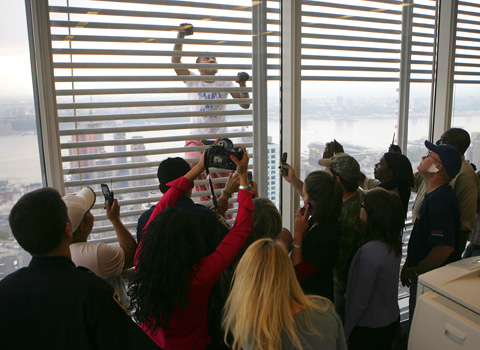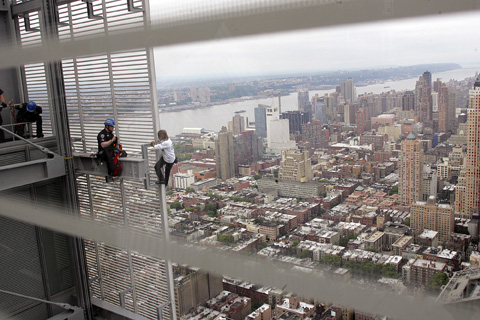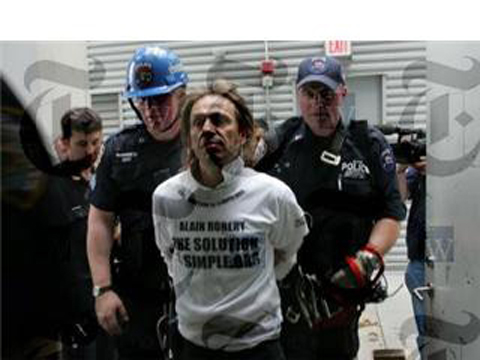Two men, one a practiced French stuntman known for climbing tall buildings, the other a New Yorker who said he wanted to raise awareness of the dangers of malaria, scaled the 52-story New York Times building on Thursday just hours apart. Each was arrested when he stepped safely onto the roof.
The first, Alain Robert, the Frenchman, started up the north face, on 41st Street, of the year-old skyscraper around 11am, unfurling a bright green banner near the top. The words on the banner were illegible from the sidewalk, but from office windows inside the tower the message could be clearly read: “Global warming kills more people than 9/11 every week.”
The other, identified by police as Renaldo Clarke, 32, of Brooklyn, climbed the 8th Avenue side starting about 6pm.

PHOTO: NY TIMES NEWS SERVICE
A spokeswoman for the Times, Catherine Mathis, said that after the first climber was arrested, two additional building security guards were assigned to patrol the area outside, on 40th and 41st streets.
In both cases, the climbers grabbed onto one of the building’s ladderlike horizontal rods that form an exterior curtain surrounding the building’s floor-to-ceiling windows.
A news cameraman who was on the scene moments after Clarke began climbing showed video indicating that he had climbed the large perforated beams rising out of the sidewalk like a jungle gym, and pulled himself easily onto the horizontal rods. It was unclear how Robert began his ascent.

PHOTO: NY TIMES NEWS SERVICE
Both times, police and Times security officers cordoned off the sidewalk below as crowds gathered. Both times, television news helicopters circled overhead, zooming in as the climber grabbed onto ever-higher rungs.
“He was staring at me on the fourth floor,” said Kim Severson, a reporter for the Times’ Dining section, who saw Clarke pass by. “At first, I thought, ‘Is he a window washer?’ But he had no equipment. He turned and climbed up at a very rapid pace. He looked very focused. He looked very solemn and determined.”
Witnesses said there appeared to be differences between the climbs. Robert seemed better prepared, with a fanny pack that contained chalk to help his grip and liquid to drink.

PHOTO: NY TIMES NEWS SERVICE
“When Alain came up this side, it was a cakewalk for him,” said Nick Mudge, 24, a chef at Covington & Burling LLP, a law firm based on the 43rd floor.
Clarke — his hands blackened by dirt from the ceramic rods — looked “fatigued” when he passed the 43rd floor, Mudge said. “He stopped and hung by his arms. His feet were just swinging back and forth.”
Clarke took to stopping at floors where there were breaks in the bars, and looking inside, where small crowds stared back.
“He mouthed to me, ‘What floor am I on?’” said Andrew Bratt, an associate at Covington & Burling. “I hand-signaled that he was on 41. He nodded and looked down and moved on. He was smiling.”
Clarke smiled even when one of the ceramic rods cracked underfoot as he made his way from the 47th floor to the 48th, another witness said.
The crowd in front of the Port Authority Bus Terminal, across 8th Avenue from the skyscraper, let out a cheer in exuberant relief when Clarke made it safely to the top. But some spectators criticized the stunt.
“He’s disrupting the city,” said Zee Mosher, 33, a graphic designer with a portrait of Buckminster Fuller tattooed on his neck. “He’s endangering his own life and the lives of other people.”
The chief spokesman for the police, Paul Browne, said that Clarke was taken to Bellevue Hospital Center for psychiatric evaluation after his arrest. Depending on the doctors’ findings, he could face charges similar to those filed against Robert, Browne said.
Shortly before 11pm, Clarke was moved from Bellevue to the Midtown South Precinct station. He emerged from Midtown South about a half-hour later.
When asked if he was a copycat climber, he said, flatly, “No.”
Officers then loaded him into a police car and took him to Central Booking to be arraigned. Robert, 45, was facing charges of reckless endangerment, criminal trespass and disorderly conduct, the police said.
After police led Clarke out of the building in handcuffs, officers put up interlocking metal barricades on the sidewalk, apparently to deter other would-be climbers.
Both climbers went down the same way, in a freight elevator surrounded by police officers, and then into police vans. Clarke said along the way that this was his third such conquest. He said he had climbed two other Manhattan buildings — including the Hearst Tower, at 56th Street and 8th Avenue — but had not been arrested either time. It was not immediately possible to confirm that claim.
When a reporter asked why he had climbed the Times building, he said, “For malaria.” He was wearing a T-shirt that said: “Malaria No More. Save the Children.” He also wore loose-fitting salmon-colored pants, a leather belt and yellow climbing shoes.
Clarke smiled, as if he was being carried victorious off an athletic field instead of being ushered into a police van. But his answers to reporters’ questions were cryptic. When he was asked how climbing the building would increase awareness of malaria, he smiled into a reporter’s video camera and said, “I’m going to be on the news, no?”
“I got to the top,” he declared.

May 11 to May 18 The original Taichung Railway Station was long thought to have been completely razed. Opening on May 15, 1905, the one-story wooden structure soon outgrew its purpose and was replaced in 1917 by a grandiose, Western-style station. During construction on the third-generation station in 2017, workers discovered the service pit for the original station’s locomotive depot. A year later, a small wooden building on site was determined by historians to be the first stationmaster’s office, built around 1908. With these findings, the Taichung Railway Station Cultural Park now boasts that it has

Wooden houses wedged between concrete, crumbling brick facades with roofs gaping to the sky, and tiled art deco buildings down narrow alleyways: Taichung Central District’s (中區) aging architecture reveals both the allure and reality of the old downtown. From Indigenous settlement to capital under Qing Dynasty rule through to Japanese colonization, Taichung’s Central District holds a long and layered history. The bygone beauty of its streets once earned it the nickname “Little Kyoto.” Since the late eighties, however, the shifting of economic and government centers westward signaled a gradual decline in the area’s evolving fortunes. With the regeneration of the once

The latest Formosa poll released at the end of last month shows confidence in President William Lai (賴清德) plunged 8.1 percent, while satisfaction with the Lai administration fared worse with a drop of 8.5 percent. Those lacking confidence in Lai jumped by 6 percent and dissatisfaction in his administration spiked up 6.7 percent. Confidence in Lai is still strong at 48.6 percent, compared to 43 percent lacking confidence — but this is his worst result overall since he took office. For the first time, dissatisfaction with his administration surpassed satisfaction, 47.3 to 47.1 percent. Though statistically a tie, for most

In February of this year the Taipei Times reported on the visit of Lienchiang County Commissioner Wang Chung-ming (王忠銘) of the Chinese Nationalist Party (KMT) and a delegation to a lantern festival in Fuzhou’s Mawei District in Fujian Province. “Today, Mawei and Matsu jointly marked the lantern festival,” Wang was quoted as saying, adding that both sides “being of one people,” is a cause for joy. Wang was passing around a common claim of officials of the People’s Republic of China (PRC) and the PRC’s allies and supporters in Taiwan — KMT and the Taiwan People’s Party — and elsewhere: Taiwan and